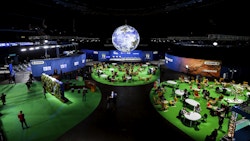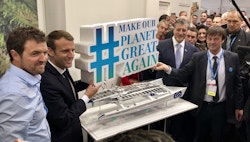COP26: The world is watching
12 years after raising climate change policy to the highest political level at the Copenhagen Climate Change conference, and 6 years after the Paris Agreement which mobilized 196 countries to intensify the actions and investments needed for a sustainable low carbon future, COP26 was launched this Sunday, October 31st, in Glasgow.
What can we expect from this conference and what are the commitments announced by the participants?

All eyes on our world’s leaders
Since Day 1 at the COP26, one message is vividly conveyed to our world leaders: Choose Action.
World leaders are requested to take the necessary decisions to reduce our carbon footprint, mobilize funding, and support adaptation and resilience. While opening this much-anticipated climate conference, the UN Secretary-General couldn’t stress enough that we are still heading for climate disaster. António Guterres urged our world representatives to take responsibility, to stop brutalizing biodiversity and killing ourselves with carbon. Enough was his final word, declaring that failing is simply not an alternative.
“COP26 is the moment where we get real about climate change. And we can.”
“Our planet is talking to us, telling us something, and so are people everywhere. Climate action tops the list of people’s concerns, across countries, ages, and gender. We must listen, we must act, and we must choose wisely. On behalf of these and future generations, I urge you: choose ambition, choose solidarity, choose to safeguard our future, and save humanity.”

New Caledonia
What is at stake during COP26?
Although recent climate action announcements might have given us the impression that we are beginning to turn the tide on the climate crisis, the UN Secretary-General reminds us that this is all but an illusion. Our planet witnessed its hottest years over these last four years. In other words, global warming’s drastic effects on our ecosystem keep on exacerbating, and we are thus, literally, digging our own grave.
Did you miss the full speech from #COP26 People’s Advocate, Sir David Attenborough?
We’ve got you covered.
📺 Watch his full speech on @YouTube
#TogetherForOurPlanet | #ClimateAction
COP26 holds 4 grounds of action:
- Secure net-zero worldwide by mid-century and keep 1.5 degrees within reach
- Adapt to protect communities and natural habitats
- Mobilize finance
- Working together to deliver
COP26 must deliver, as we are one minute to midnight on the doomed climate clock.
What is happening now at COP26?
While major world nations leaders, such as China and Russia, have declined their invitation to join the summit in Glasgow, COP26 has already taken action.
Ending deforestation
Over 100 leaders have committed to halt and reverse forest loss and land degradation by 2030.
The global forest finance pledge
France is part of the coalition that mobilized US$12 billion for forest-related climate finance between 2021-2025. This funding is destined to forest countries where increased ambition and concrete steps are shown towards ending deforestation by no later than 2030.
Renewable energy to mobilize an international market
Trading energy from sun, wind and water across borders, to deliver more than enough clean energy to meet the needs of everyone on earth: this is the ambition of the One Sun One World declaration. This trading is already happening through bilateral and regional arrangements. Yet, this declaration aims to create a more inter-connected global grid, which is why it is called: One Sun One World One Grid.
The Breakthrough Agenda
The United Kingdom, with a coalition of 42 world leaders, have launched an unprecedented international clean technology plan to keep 1.5 degree in reach. This agenda marks a commitment to work together internationally this decade to accelerate the development and deployment of the clean technologies and sustainable solutions needed to meet our Paris Agreement goals, ensuring they are affordable and accessible for all.
A global methane pledge
The European Union and the United States have established a joint agreement to reduce global methane emissions to 30% by 2030. This pledge could mark the turning point of this COP, knowing that methane emissions alone are responsible for over a quarter of the world’s global warming.
Supporting South Africa’s Energy Transition
South Africa, France, UK, Germany, and USA have forged an alliance to help and support South Africa in its decarbonization journey.
What is a COP?
A Conference of the Parties (COP) is led by the United Nations Framework Convention on Climate Change and unites national delegations, world leaders, and world organizations, while welcoming the general public. Its aim is to turn the world’s ambitions into action by accelerating collaboration between governments, businesses and civil society to deliver on our climate goals faster.
“We are after all the greatest problem solvers to have ever existed on earth. We now understand this problem. We know how to stop the number rising, and put it in reverse.”
During COP, formal negotiations and compromises between present parties take place. Yet, it also sets the stage for delegates to meet for informal consultancies and inform their position and interests. The aim is to reach an agreement or overcome a negotiating deadlock.
Looking back at the importance of the Paris Agreement
COP21 in Paris marked a turning point, as it mobilized 196 countries to take action against global warming. The 1.5-degree limit was established, and the release of funds to achieve these goals was determined during the Paris Agreement. The importance of this agreement lies in its central aim to strengthen the global response to the threat of climate change by keeping a global temperature rise this century well below 2 degrees Celsius.

Victorien Erussard and Emmanuel Macron in 2018
Why is the 1.5-degree limit an important commitment?
The 1.5-degree commitment is crucial because every added fraction of a degree to global warming holds dramatic impacts on our ecosystem. Global warming of 2 degrees would have widespread and irreversible repercussions on people and nature. One-third of the world's population would be regularly exposed to high heat, leading to health problems and infinite heat-related deaths.
Explicitly, what does this mean?
Nearly all warm-water coral reefs would be destroyed, and Arctic sea ice would melt entirely, at least one summer per decade, with devastating effects on the wildlife and communities it supports. We cannot rule out the possibility of triggering irreversible loss of the Greenland and Antarctic ice sheets, resulting in several meters of sea-level rise over the coming centuries.
At 1.5°C, the impacts would be severe but less significant. There would be less risk of food and water shortages, less jeopardy to economic growth, and fewer species in peril of extinction. Threats to human health from air pollution, disease, malnutrition, and exposure to extreme heat would also be less significant. That's why every fraction of a degree of warming matters. And this is why we strive to maintain the 1.5-degree temperature increase outlook.
5 years later, most of the countries show a mixed record of their roadmap established during the Paris Agreement. 5 years later, our ecosystem is at risk and we are running out of time